
Are islands innovation hubs?
Unlike their mainland kin, white-faced capuchin monkeys (Cebus imitator) living on the islands of Jicarón and Coiba, in Panama, habitually use stone tools. This gives capuchins efficient access to invertebrate prey and allows them to incorporate new fruits and nuts into their diets. But, how and why are only a few groups of capuchins in the Coiban archipelago developing this tradition? Across species, we see that tool use is over-represented on islands. What ecological aspects of island living make Coiba National Park the only place in the world where capuchins in the genus Cebus use stone tools?
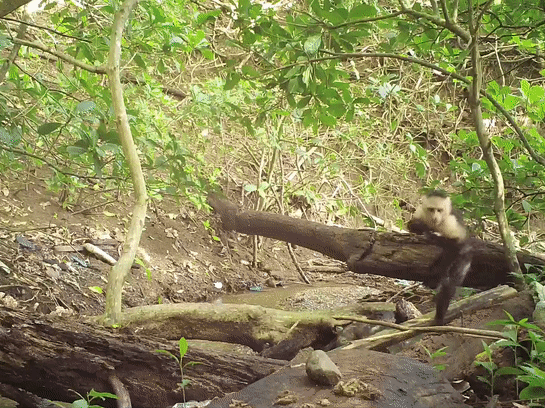
Our Inheritance and Social Learning across Scales (ISLaS) Team, led by Brendan Barrett in the Department for the Ecology of Animal Societies, is studying cultural traditions like stone-tool use in collaboration with paleoanthropologists, archaeologists and geneticists from LEIZA - Leibniz-Zentrum für Archäologie, UC Davis, University of Calgary and the Max Planck Institute for Evolutionary Anthropology. We aim to understand the evolution, drivers of innovation, and transmission of tool-use and social, behavioral, cultural, and genetic adapation to island ecosystems. We investigate these fields in island-living capuchin monkeys, using non-invasive observation methods, including motion-triggered cameras, and genetic sampling from hair traps and feces. From a broader taxonomic perspective, tool-use is unusually common in island-living species. What aspects of island ecology make these isolated locales hotbeds of cultural innovation—both seemingly adaptive and otherwise?
What hinders the transmission of tool use among groups?
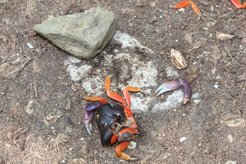
Halloween crab cracked open with a hammerstone on an anvil
We aim to understand why only some groups of capuchins on these islands use tools and others do not, despite having access to the required resources. What are the barriers to the transmission of this skill? Why do only males seem to use stone-tools? One tantalizing possibility is that female capuchins on the Coiban archipelago might have become the dispersing sex. Since females do not seem to use tools, such a reversal of philopatry could explain why the tool-use tradition remains restricted to a small number of groups and has not spread throughout the population. To answer these questions, we are surveying broader areas, and analyzing genetic relatedness within and among groups.
What drives innovation?
Why do island populations often develop tool use traditions? Across taxa, we find a higher incidence of foraging innovation and tool use among island populations, when compared to their mainland kin. New Caledonian crows, for example, form hooks to forage from crevices and island-living populations of long-tailed macaques in Thailand use axe‐shaped stones to crack shellfish.
Explanations for this pattern may include the comparably limited food resources available on islands, seasonal dryness, and the access to both hard-shelled food resources in the intertidal zone and appropriate tool materials. High population density and competition may also play a role in driving individuals to pursue novel foraging strategies.
We recently discovered that the tool-using capuchins on Jicarón have innovated an entirely unique behavior: abducting and carrying infant howler monkeys. Our camera traps documented the origin of this behavior, and its spread to become a social tradition –read the publication, and an interactive online timeline. That this tradition arose here on this island further suggests that there are conditions conducive to innovations, both of seemingly useful behaviors like tool use, and seemingly less useful behaviors like interspecies abduction.
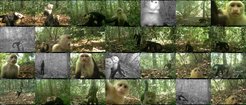
Importantly, on the islands of Jicarón and Coiba, capuchin monkeys are not exposed to mammalian predators, which allows them to more safely exploit the terrestrial niche. Based on camera trap surveys, these groups of capuchin monkeys are 200 times more likely to be observed on the ground than their mainland counterparts who must contend with terrestrial predators like ocelots, puma and jaguar. Increased access to and safety on the ground may help to explain how tool-use traditions arose — but cause and effect remain unclear. Are these primates driven into the terrestrial niche because of low resource availability and/or high population density? Or does safety on the ground allow them to expand their foraging niche through the innovation of tool-use traditions?
Understanding human origins
Living on the ground instead of the canopy is one major step in human evolution. Tool use was long time thought to be the defining characteristic of humans. Now we know we are far from alone: many other animals also use tools. What can they teach us about who we are as a species? A hyper-reliance on social learning and tool use is central to our evolutionary journey. It explains, in part, why humans — long-lived, slowly reproducing apes — have been so successful in myriad ecosystems. Comparative studies of social learning and cultural traditions in non-humans highlight the commonalities, contrasts, and counterfactuals that can inform our understanding of human evolution. Capuchin monkeys and humans diverged from our last common ancestor about 38 million years ago. Like humans, they have a slow life history, including an extended juvenile phase, are highly cooperative, and rely on social learning and culture. These similarities make capuchins an ideal comparative system for understanding human evolution.
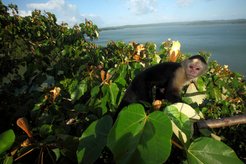
Stone-tools found in the fossil record offer us a glimpse into how percussive technologies allowed our ancestors to extract food in the early stone age. However, we cannot make direct observations of early human tool use behavior, limiting the certainty of how artifacts were used and how tool use evolved two million years ago.
As behavior and resource distribution are not preserved in the fossil record, observing real-time stone tool use in Coiban capuchins might shed light onto early hominin behavior. In particular, mapping capuchin behavior onto lithic and debris accumulation at anvils, we can understand which sites are likely to be preserved or erased, and we can better understand preservation biases and interpret archaeological finds.
Methods
Because the study site is difficult to access and the capuchins are not habituated to human observers, we must design creative solutions to study the evolution of tool use including indirect observation and state-of-the-art computational methods.
We perform non-invasive genetic sampling using hair traps to better understand the groups’ social systems. Genetic data provides insight into their demography, population dynamics such as dispersal tendencies between groups, and their evolutionary history.

We catalogue used tools and set up motion-sensor camera traps in order to “observe” tool use behaviors. By applying deep learning approaches, we are developing convolutional neural networks that can recognize individuals from camera trap recordings. This will help us identify which individuals within groups are using tools, and thus enable us to better understand pathways of cultural transmission and social learning, the prevalent male bias, and intergroup differences in tool-use tendencies.
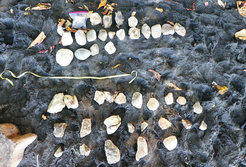
To add to our understanding of what drives cultural transmission and behavioral diversity, we develop theoretical models that explain what particular aspects of island ecology drive foraging innovation. We aim to test our models empirically in a comparative within- and between-species context, on tool-using populations on the archipelago, non-tool-using mainland populations across Central America in collaboration with Susan Perry of UCLA, and on other tool using primates, e.g. long-tailed macaques who process some of the same foods in collaboration with Lydia Luncz of the MPI for Evolutionary Anthropology, Leipzig.
Conservation
Ultimately, conservation of habitats, species and culture is of major importance to us. We aim to document Coiba National Park’s biodiversity, and will make our camera trap data publicly available. This will facilitate the cataloguing and investigation of the biodiversity of this understudied archipelago. We hope to highlight the importance of conservation efforts of this UNESCO world heritage site, a safe haven to a number of threatened and endemic animal and plant species. There is also an increasing acknowledgment of the importance of conserving cultural and behavioral diversity, both for its own inherit sake and to understand how culture helps animals respond to changing environment. Documenting this behavior and further exploring Coiba National Park in collaboration with local researchers is important to understand our story, both past and future.
Further reading & Cited articles
The rise and spread of a social tradition of interspecies abduction (2025)
Male-biased stone tool use by wild white-faced capuchins (2024)
Coupling of coastal activity with tidal cycles is stronger in tool-using capuchins (2023)
Habitual stone-tool-aided extractive foraging in white-faced capuchins (2018)
Want to learn more about capuchin monkeys?
Female Sociability in Capuchin and Red Colobus monkeys
Resources
Data and code for graphing and analysis of Hammerstone and Anvil Tool Use in Riparian Habitats on Coiba Island, Panama (2020)
Written by Bianca Schell, Scientific Writer & Web Editor, Department for the Ecology of Animal Societies
Photos provided by Brendan Barrett, Claudio Monteza-Moreno and Christian Ziegler









